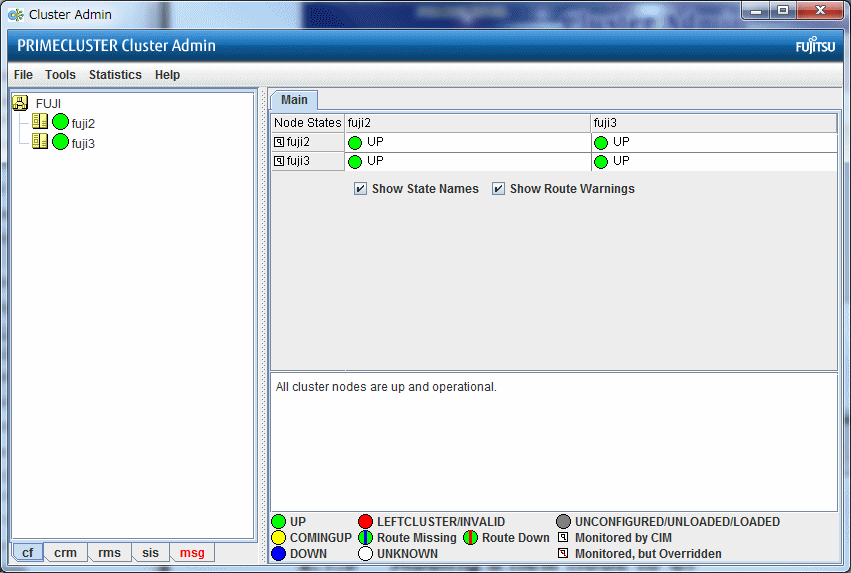The following example shows what the Web-Based Admin View and Cluster Admin screens would look like when creating a two-node cluster. The nodes involved are named fuji2 and fuji3, and the cluster name is FUJI.
This example assumes that Web-Based Admin View configuration has already been done. fuji2 is assumed to be configured as the primary management server for Web-Based Admin View, and fuji3 is the secondary management server.
First, start GUI in one of the following ways.
Startup from the command (recommended)
Press [Win]+[R] key on the client and to open the dialog box [Run], and then input the javaws command with the format below.
javaws http://management_server:8081/If the host name of the management server is fuji2, enter the following.
javaws http://fuji2:8081/
Startup from the Web browser (If using Java Web Start)
Enter the URL below in the Web browser address bar.
http://management_server:8081/If the host name of the management server is fuji2, enter the following.
http://fuji2:8081/
Startup from the Web browser (If using Java Plug-in)
Enter the URL below in the Web browser address bar.
http://management_server:8081/Plugin.cgiIf the host name of the management server is fuji2, enter the following.
http://fuji2:8081/Plugin.cgi
For more information on how to start Cluster Admin GUI and Web-Based Admin View, refer to "3.1 Prerequisite for screen startup" and "3.2 Screen startup" in "PRIMECLUSTER Web-Based Admin View Operation Guide."
After a few moments, a login pop-up appears asking for a user name and password (similar to the screen below).
Figure 1.3 Login pop-up

Since you will be running the Cluster Admin CF Wizard, which does configuration work, you will need a privileged user ID such as root. There are three possible categories of users with sufficient privilege:
The user root
You can enter root for the user name and root's password on fuji2. The user root is always given the maximum privilege in Web-Based Admin View and Cluster Admin.
A user in group clroot
You can enter the user name and password for a user on fuji2 who is part of the UNIX group clroot. This user will have maximum privilege in Cluster Admin, but will be restricted in what Web-Based Admin View functions they can perform. This should be fine for CF configuration tasks.
A user in group wvroot
You can enter the user name and password for a user on fuji2 who is part of the UNIX group wvroot. Users in wvroot have maximum Web-Based Admin View privileges and are also granted maximum Cluster Admin privileges.
For further details on Web-Based Admin View and Cluster Admin privilege levels, see "4.2.1 Assigning Users to Manage the Cluster" in "PRIMECLUSTER Installation and Administration Guide."
After clicking on the [OK] button, the top menu screen below appears. Click on the button labeled [Global Cluster Services].
Figure 1.4 Main Web-Based Admin View window after login

The Cluster Admin Selection screen below appears.
Figure 1.5 Global Cluster Services window in Web-Based Admin View
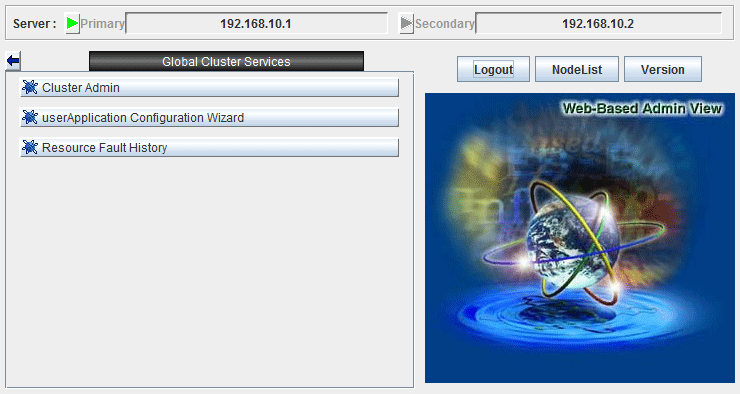
Click on the button labeled [Cluster Admin] to launch the Cluster Admin GUI. Choose a node for initial connection window appears below.
Figure 1.6 Initial connection pop-up
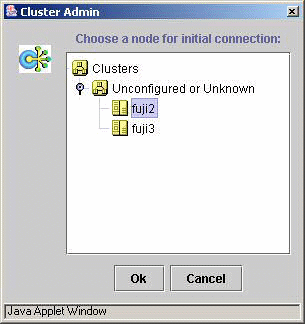
In the screen that selects the node for this initial connection, lists the nodes that are known to the Web-Based Admin View management station. However, if you select a node where CF has not yet been configured, the node is not displayed on the list in the [Node] tab. In this example, neither fuji2 nor fuji3 have had CF configured, so either would be acceptable as a choice. In the above screen, fuji2 is selected.
Clicking on the [OK] button causes the main Cluster Admin GUI to appear. Since CF is not configured on fuji2, a window similar to the one below appears.
Figure 1.7 CF is unconfigured and unloaded
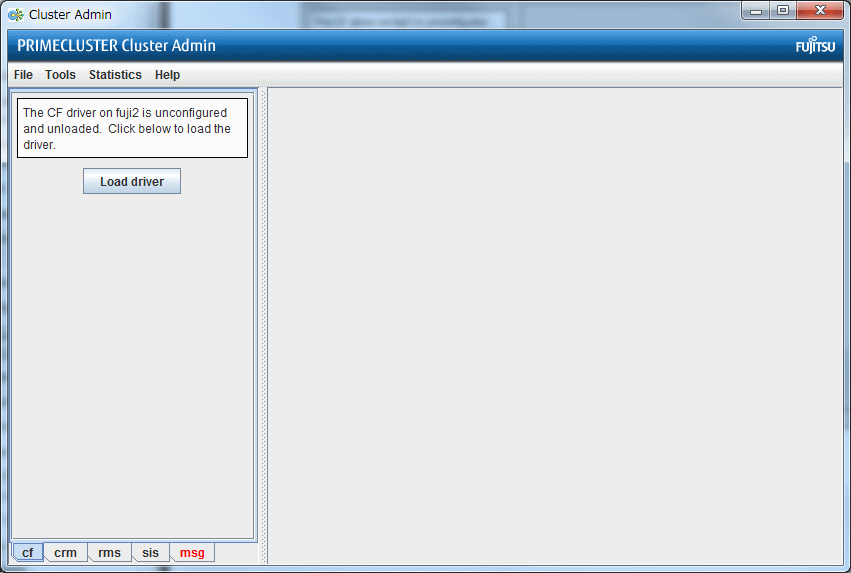
Click on the [Load driver] button to load the CF driver.
A window indicating that CF is loaded but not configured appears (similar below).
Figure 1.8 CF loaded but not configured
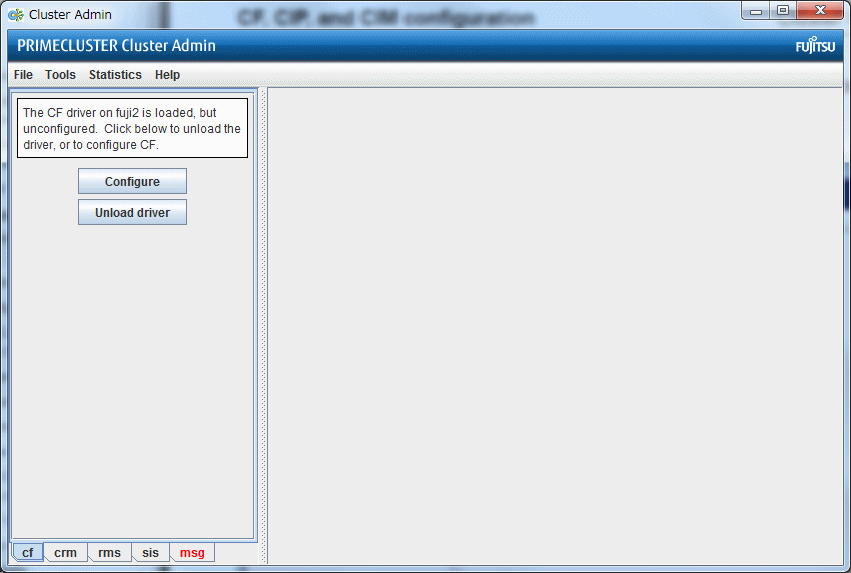
Click on the [Configure] button to bring up the CF Wizard.
The CF Wizard begins by looking for existing clusters (screen below).
Figure 1.9 Scanning for clusters

After the CF Wizard finishes looking for clusters, the screen below is displayed.
Figure 1.10 Creating or joining a cluster
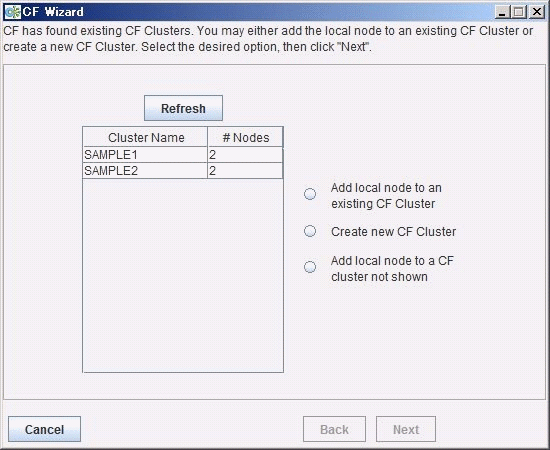
This window lets you decide if you want to join an existing cluster or create a new one.
A pure CF over IP cluster will not show up in the Cluster Name column. To join a CF over IP cluster, select the Add local node to a CF cluster not shown radio button and click [Next].
Figure 1.11 Adding a local node to a CF cluster not shown
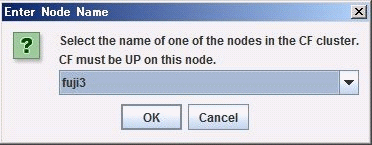
Enter the node name of the CF cluster that you want to join. Click [OK] to proceed.
After scanning the node and retrieving the existing cluster's details, the CF wizard takes you to the window for joining an existing cluster.
To create a new cluster, select the [Create new CF Cluster radio] button as shown in "Figure 1.10 Creating or joining a cluster." Then, click [Next]. Depending on your previous selection, a window for creating a new cluster or joining a cluster appears. The figure below is the screen for creating new cluster. The window for joining an existing cluster is very similar, except you cannot change the cluster name.
Figure 1.12 Selecting cluster nodes and the cluster name
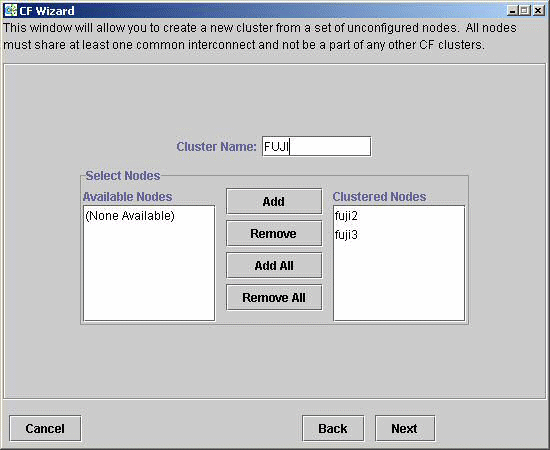
This window lets you chose the cluster name and also determine what nodes will be in the cluster. In the example above, we have chosen FUJI for the cluster name.
Below the cluster name are two boxes. The one on the right, under the label Clustered Nodes, contains all nodes that you want to become part of this CF cluster. The box on the left, under the label Available Nodes, contains all the other nodes known to the Web-Based Admin View management server. You should select nodes in the left box and move them to the right box using the Add or Add All button. If you want all of the nodes in the left box to be part of the CF cluster, then just click on the Add All button.
If you get to this window and you do not see all of the nodes that you want to be part of this cluster, then there is a very good chance that you have not configured Web-Based Admin View properly. When Web-Based Admin View is initially installed on the nodes in a potential cluster, it configures each node as if it were a primary management server independent of every other node. If no additional Web-Based Admin View configuration were done, and you started up Cluster Admin on such a node, then this screen would show only a single node in the right-hand box and no additional nodes on the left-hand side. If you see this, then it is a clear indication that proper Web-Based Admin View configuration has not been done.
See "4.2 Preparations for Starting the Web-Based Admin View Screen" in "PRIMECLUSTER Installation and Administration Guide" for more details on Web-Based Admin View configuration.
After you have chosen a cluster name and selected the nodes to be in the CF cluster, click on the [Next] button.
The CF Wizard then loads CF on all the selected nodes and does CF pings to determine the network topology. While this activity is going on, a window similar to the one below appears.
Figure 1.13 CF loads and pings
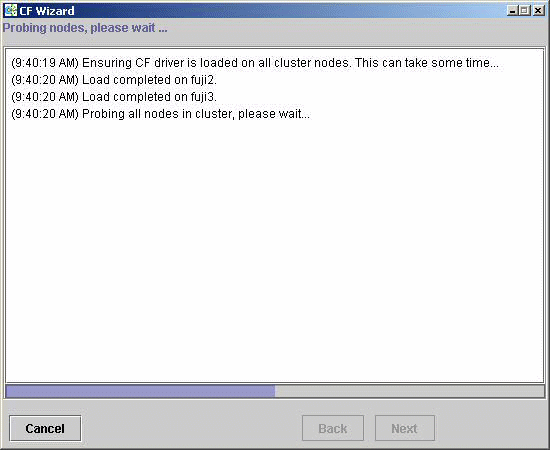
On most systems, loading the CF driver is a relatively quick process. However, on some systems that have certain types of large disk arrays, the first CF load can take up to 20 minutes or more.
The window that allows you to edit the CF node names for each node appears (see Figure 13). By default, the CF node names, which are shown in the right-hand column, are the same as the Web-Based Admin View names which are shown in the left-hand column.
Figure 1.14 Editing CF node name
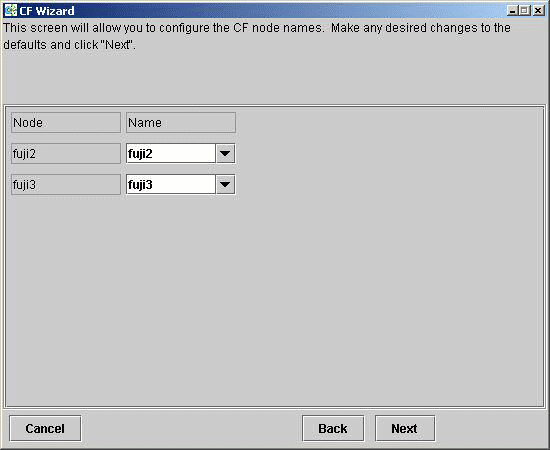
Make any changes to the CF node name and click Next.
After the CF Wizard has finished the loads and the pings, the CF topology and connection table appears (similar below).
Figure 1.15 CF topology and connection table
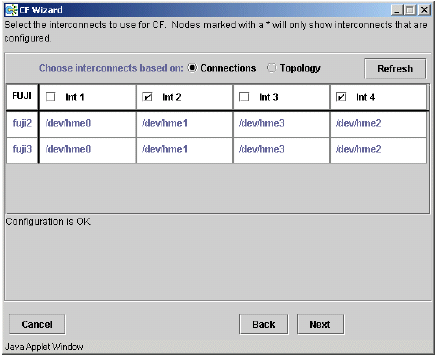
Before using the CF topology and connection table of this screen, you should understand the following terms:
An interconnect where CF communication is possible to all nodes in the cluster.
An interconnect where CF communication is possible between at least two nodes, but not to all nodes. If the devices on a partial interconnect are intended for CF communications, then there is a networking or cabling problem somewhere.
These devices are potential candidates for CF configuration, but are not able to communicate with any other nodes in the cluster.
The CF Wizard determines all the full interconnects, partial interconnects, and unconnected devices in the cluster using CF pings. If there are one or more full interconnects, then it will display the connection table shown in "Figure 1.15 CF topology and connection table."
The connection table lists all full interconnects. Each column with an Int header represents a single interconnect. Each row represents the devices for the node whose name is given in the left-most column. The name of the CF cluster is given in the upper-left corner of the table.
In "Figure 1.15 CF topology and connection table", for example, Interconnect 1 (Int 1) has /dev/hme0 on fuji2 and fuji3 attached to it. The cluster name is FUJI.
Note
The connections and topology tables typically show devices that are on the public network. Using devices on a public network is a security risk; therefore, in general, do not use any devices on the public network as a CF interconnect. Instead, use devices on a private network.
To configure CF using the connection table, click on the interconnects that have the devices that you wish to use. In "Figure 1.15 CF topology and connection table," Interconnects 2 and 4 have been selected. If you are satisfied with your choices, then you can click on [Next] to go to the CIP configuration window.
Occasionally, there may be problems setting up the networking for the cluster. Cabling errors may mean that there are no full interconnects. If you click on the button next to [Topology], the full interconnects, partial interconnects, and the devices that belong to the unconnected category and each category detected by the CF Wizard are displayed. A category where no target device exists is not displayed.
The topology table gives more flexibility in configuration than the connection table. In the connection table, you could only select an interconnect, and all devices on that interconnect would be configured. In the topology table, you can individually select devices.
While you can configure CF using the topology table, you may wish to take a simpler approach. If no full interconnects are found, then display the topology table to see what your networking configuration looks like to CF. Using this information, correct any cabling or networking problems that prevented the full interconnects from being found. Then go back to the CF Wizard window where the cluster name was entered and click on [Next] to cause the Wizard to reprove the interfaces. If you are successful, then the connection table will show the full interconnects, and you can select them. Otherwise, you can repeat the process.
The text area at the bottom of the window lists problems or warnings concerning the configuration.
If the CF interconnect and the device are configured successfully, click [Next]. The "Figure 1.16 "CF over IP" window" is displayed.
Since CF over IP is not supported in a Solaris 11 or later environment, the CIP Wizard window as shown in the "Figure 1.16 "CF over IP" window" is not displayed. The "Figure 1.17 CIP wizard (IPv4) window" is displayed.
Select one or more full interconnects in the CF topology and connection table, and click [Next].
The "Figure 1.18 CIP wizard (IPv6) window" is displayed.
Figure 1.16 "CF over IP" window
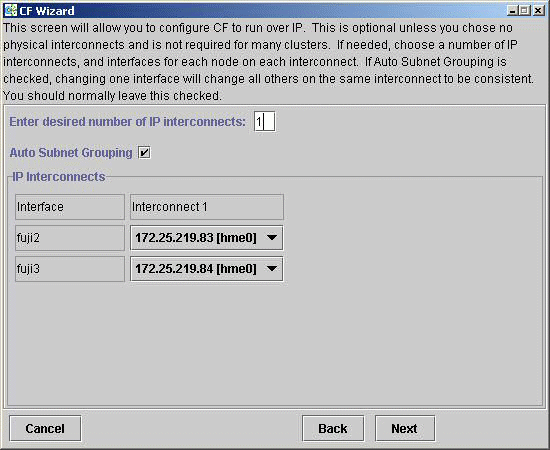
This is optional. If desired, enter the desired number of IP interconnects and press [Return]. The CF Wizard then displays interconnects sorted according to the valid subnetworks, netmasks, and broadcast addresses.
All the IP addresses for all the nodes on a given IP interconnect must be on the same IP subnetwork and should have the same netmask and broadcast address. CF over IP uses the IP broadcast address to find all the CF nodes during join process. So the dedicated network should be used for IP interconnects.
Auto Subnet Grouping should always be checked in this window. If it is checked and you select one IP address for one node, then all of the other nodes in that column have their IP addresses changed to interfaces on the same subnetwork.
Choose the IP interconnects from the combo boxes in this window, and click on [Next]. The "Figure 1.17 CIP wizard (IPv4) window" and "Figure 1.18 CIP wizard (IPv6) window" appear.
Figure 1.17 CIP wizard (IPv4) window
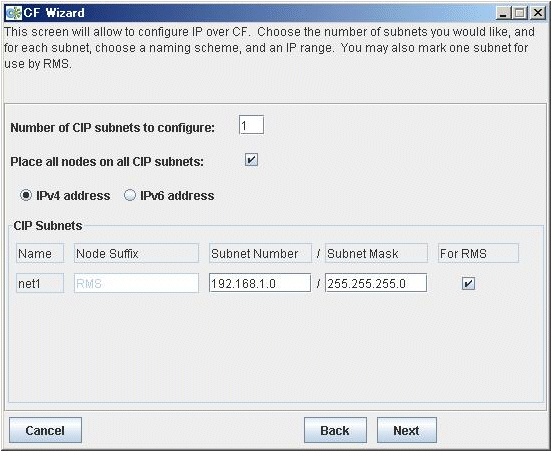
Figure 1.18 CIP wizard (IPv6) window
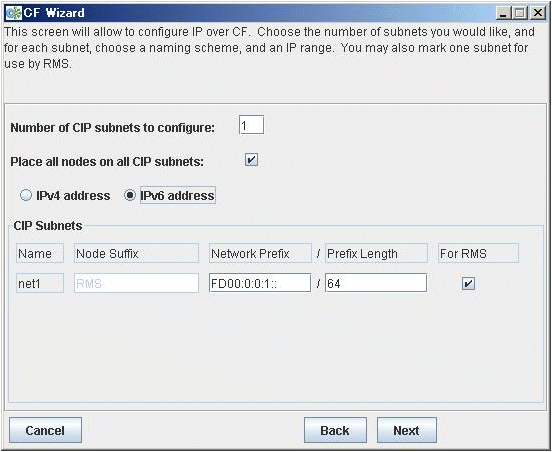
This window allows you to configure CIP. You can enter a number in the box after Number of CIP subnets to configure to set the number of CIP subnets to configure. The maximum number of CIP subnets is 8.
For each defined subnet, the CIP Wizard configures a CIP interface on each node defined in the CF cluster.
Set either IPv4 or IPv6 as the IP address to set to the CIP interface.
By selecting either of the [IPv4 address] or [IPv6 address] radio button, you can switch "Figure 1.17 CIP wizard (IPv4) window" and "Figure 1.18 CIP wizard (IPv6) window".
When using IPv4 for CIP interface
The following values are assigned for CIP interface:
The IP address will be a unique IP number on the subnet specified in the Subnet Number field. The node portions of the address start at 1 and are incremented by 1 for each additional node.
Refer to "1.1.6 Example of CF setting by using CLI" to set any IP address.
The CIP Wizard will automatically fill in a default value for the Subnet Number for each CIP subnetwork requested. The default values are taken from the private IP address range specified by RFC 1918. Note that the values entered in the Subnet Number have 0 for their node portion even though the CIP Wizard starts the numbering at 1 when it assigns the actual node IP addresses.
The IP name of the interface will be of the form cfnameSuffix where cfname is the name of a node from the CF Wizard, and the Suffix is specified in the field Host Suffix.
If the checkbox For RMS is selected, then the host suffix will be set to RMS and will not be editable. If you are using RMS, one CIP network must be configured for RMS.
The Subnet Mask will be the value specified.
In "Figure 1.17 CIP wizard (IPv4) window", the system administrator has selected 1 CIP network. The For RMS checkbox is selected, so the RMS suffix will be used. Default values for the Subnet Number and Subnet Mask are also selected. The nodes defined in the CF cluster are fuji2 and fuji3. This will result in the following configuration:
On fuji2, a CIP interface will be configured with the following:
IP nodename: fuji2RMS IP address: 192.168.1.1 Subnet Mask: 255.255.255.0
On fuji3, a CIP interface will be configured with the following:
IP nodename: fuji3RMS IP address: 192.168.1.2 Subnet Mask: 255.255.255.0
When using IPv6 for CIP interface
The following values are assigned for CIP interface:
The IP address is a unique IP number on the network prefix specified in the [Network Prefix] field. The interface ID of the address starts from 1 and it is incremented by 1 for each additional node.
Refer to "1.1.6 Example of CF setting by using CLI" to set any IP address.
The CIP Wizard will automatically fill in a default value for the [Network Prefix] field for each CIP subnetwork requested. The default values are taken from the Unique Local Unicast Address range specified by RFC 4193. Note that the values entered in the [Network Prefix] field have 0 for their interface ID portion even though the CIP Wizard starts the numbering at 1 when it assigns the actual node IP addresses.
The IP name of the interface will be of the form cfnameSuffix where cfname is the name of a node from the CF Wizard, and the Suffix is specified in the field [Node Suffix]. If the checkbox [For RMS] is selected, then the [Node Suffix] will be set to RMS and will not be editable. If you are using RMS, one CIP network must be configured for RMS.
The [Prefix Length] will be the value specified.
In "Figure 1.18 CIP wizard (IPv6) window", the system administrator has selected 1 CIP network. The [For RMS] checkbox is selected, so the RMS suffix will be used. Default values for the [Network Prefix] and [Prefix Length] are also selected. The nodes defined in the CF cluster are fuji2 and fuji3. This will result in the following configuration:
On fuji2, a CIP interface will be configured with the following:
IP nodename: fuji2RMS IPv6 address: FD00:0:0:1::1 Prefix Length: 64
On fuji3, a CIP interface will be configured with the following:
IP nodename: fuji3RMS IPv6 address: FD00:0:0:1::2 Prefix Length: 64
The CIP Wizard stores the configuration information in the file /etc/cip.cf on each node in the cluster. This is the default CIP configuration file. The Wizard will also automatically update /etc/hosts and /etc/inet/ipnodes on each node in the cluster to add the new IP nodenames. The cluster console will not be updated.
Note
The CIP Wizard always follows an orderly naming convention when configuring CIP names. If you have done some CIP configuration by hand before running the CIP Wizard, then you should consult the Wizard documentation to see how the Wizard handles irregular names.
When you click on the [Next] button, the window below appears.
Figure 1.19 CIM configuration window
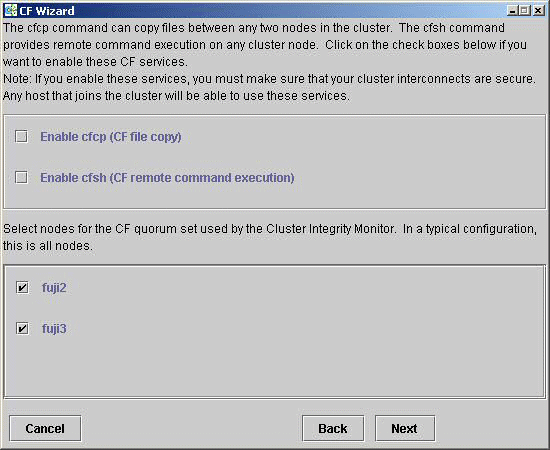
The CIM configuration window in Figure 1.18 has the following parts:
The upper portion allows you to enable cfcp and cfsh.
cfcp is a CF-based file copy program. It allows files to be copied among the cluster hosts. cfsh is a remote command execution program that similarly works between nodes in the cluster. The use of these programs is optional. In this example these items are not selected. If you enable these services, however, any node that has access to the cluster interconnects can copy files or execute commands on any node with root privileges.
The lower portion allows you to determine which nodes should be monitored by CIM.
This window also lets you select which nodes should be part of the CF quorum set. The CF quorum set is used by the CIM to tell higher level services when it is safe to access shared resources.
Note
Do not change the default selection of the nodes
Do not manually add the CIP node name to the /etc/hosts, /etc/inet/ipnodes because, each node of /etc/hosts, /etc/inet/ipnodes files with in the cluster are automatically renewed.
A checkbox next to a node means that node will be monitored by CIM. By default, all the nodes are checked. For almost all configurations, you will want to have all the nodes monitored by CIM.
This window will also allow you to configure CF Remote Services. You can enable either remote command execution, remote file copying, or both.
Note
Enabling either of these means that you must trust all the nodes on the CF interconnects and the CF interconnects must be secure. Otherwise any system able to connect to the CF interconnects will have access to these services.
To use RMS, make sure to configure cfcp and cfsh.
Click on the [Next] button to go to the summary window below.
Figure 1.20 Summary window

This window summarizes the major changes that the CF, CIP, and CIM Wizards will perform. When you click on the [Finish] button, the CF Wizard performs the actual configuration on all the nodes.
The window below is displayed while the configuration is being done.
Figure 1.21 Configuration processing window
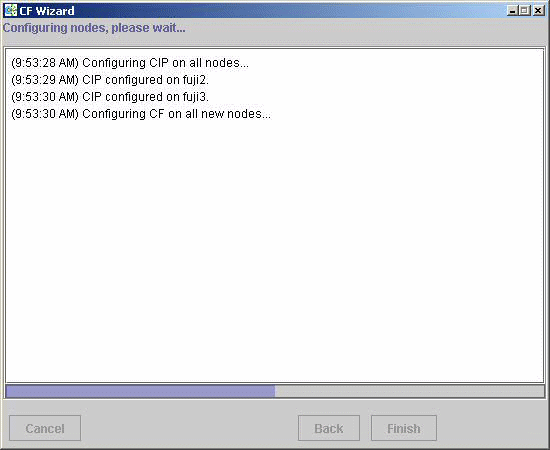
This window is updated after each configuration step. When the configuration successfully completes, a completion pop-up window similar to the one below appears.
Figure 1.22 Configuration completion pop-up
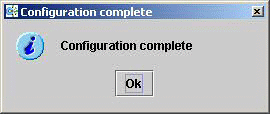
Click on the [OK] button to close the pop-up window. A [Finish] button is being displayed, for the configuration processing window similar to the one below.
Figure 1.23 Configuration window after completion
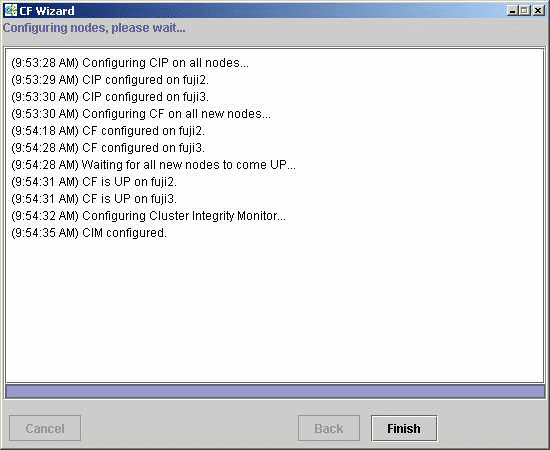
You might see the following error message in the window shown in "Figure 1.23 Configuration window after completion."
cf:cfconfig OSDU_stop: failed to unload cf_drv
You can safely ignore this message.
When the CF Wizard is run on an unconfigured node, it will ask the CF driver to push its modules on every Ethernet device on the system. This allows CF to do CF pings on each interface so that the CF Wizard can discover the network topology.
Occasionally, this unload will fail. To correct this problem, you need to unload and reload the CF driver on the node in question. This can be done easily through the GUI (refer to "4.7 Starting and stopping CF").
Click on the [Finish] button to dismiss the window in Figure 22. A small pop-up appears asking if you would like to run the SF Wizard. Click on [Yes], and run the SF Wizard (described in "7.2.1 Setting procedure before configuring SF").
After the CF (and optionally the SF) Wizards are done, you see the main CF window. After several moments, the window will be updated with new configuration and status information (see Figure below).
Figure 1.24 Main CF window
